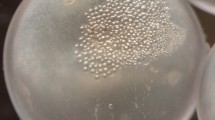Abstract
The common Pacific coast mudstone boring bivalve Adula californiensis (Phillippi) 1847 is useful for laboratory studies on molluscan development. It is in spawning condition from June through October in Oregon, USA. It is easily reared in the laboratory by the methods described in this paper, and its development is typical of the group. A description of major features of early development and the effect of temperature and salinity on developmental rate is given. At 33.2‰ S and 15°C, the first and second cleavages take place 1 1/2 and 2 1/2 h after fertilization. The trochophore stage is reached in 15 h and the shell gland becomes apparent at 31 h. By 72 h, the larval shell completely encloses the soft parts. Developmental rate increases linearly with temperature. Lowered salinity retards developmental rate, and development is abnormal below 26.3‰ S. Larvae do not congregate at salinity interfaces, but avoid low salinities in gradient experiments. Veligers swim rapidly and vertically in both directions, but show no ability to swim horizontally. After 3 days in laboratory culture, the larvae settled and survived for long periods of time; metamorphosis did not occur, however.
Similar content being viewed by others
Literature cited
Amemiya, I.: Observations on the early stages of the development of the oyster and the effect of salinity upon it. Suisan Gakkwai Ho 3, 150–181 (1921). [Abstr. No. 121, Jap. J. Zool. 1 (1), (1922)].
—: Notes on experiments on the early developmental stages of the Portuguese, American and English native oysters, with special reference to the effect of varying salinity. J. mar. biol. Ass. U.K. 14, 161–175 (1926).
—: Ecological studies of Japanese oysters with special reference to the salinity of their habits. J. imp. Coll. agric. Univ. Tokyo 9, 334–382 (1928). [Reviewed by H. P. Sherwood. J. Cons. perm. int. Explor. Mer 3, 407–409 (1928)].
Bayne, B. L.: Growth and the delay of metamorphosis of the larvae of Mytilus edulis (L.) Ophelia 2, 1–47 (1965).
Clark, A. E.: The effects of temperature and salinity on the early development of the oyster. Prog. Rep. Atl. biol. Stn 16, p. 10 (1935).
Costello, D. P., M. E. Davidson, A. Eggers, M. H. Fox and C. Henley: Methods for obtaining and handling marine eggs and embryos, 247 pp. Lancaster: Lancaster Press 1957.
Davis, H. C.: Survival and growth of clam and oyster larvae at different salinities. Biol. Bull. mar. biol. Lab., Woods Hole 114, 296–307 (1958).
Harder, W.: Reactions of plankton organisms to water stratification. Limnol. Oceanogr. 13, 156–168 (1968).
Loosanoff, V. L. and H. C. Davis: Rearing of bivalve molluscs. In: Advances in marine biology, Vol. 1, pp 1–136. Ed. by F. S. Russel. London: Academic Press 1963.
—, W. S. Millas and P. B. Smith: Growth and setting of larvae of Venus mercenaria in relation to temperature. J. mar. Res. 10, 59–81 (1951).
Matthiessen, G. C. and R. C. Toner: Possible methods of improving the shellfish industry of Martha's Vineyard, Duke's County, Massachusetts, 138 pp. Edgartown, Mass.: Marine Research Fdn Inc, 1966.
Nikitin, N. W. and E. P. Turpaeva: The euryhalinity of some species of the Black Sea benthos and the possibility of their settlement in the Sea of Azov. Trud y Inst. Okeanol. 20, 60–87 (1957). (Marine biology, Vol. 20, pp 45–66. Ed. by B. N. Nikitin. Washington, D. C.: Am. Inst. Biol. Sci. 1959).
Patel, B. and D. J. Crisp: Rates of development of the embryos of several species of barnacles. Physiol. Zoöl. 33, 104–119 (1960).
Rao, K. V.: Observations on the probable effects of salinity on the spawning, development and setting of the Indian backwater oyster, Ostrea madrasensis Preston. Proc. Indian Acad. Sci. (Sect. B) 33, 231–256 (1951).
Schales, O. and S. S. Schales: A simple and accurate method for the determination of chloride in biological fluids. J. biol. Chem. 140, 879–884 (1941).
Seno, H., J. Hori and D. Kusakabe: Effects of temperature and salinity on the development of the eggs of the common Japanese oyster, Ostrea gigas Thunberg. J. imp. Fish. Inst., Tokyo 22, 41–47 (1926).
Soot-Ryen, T.: A report on the family Mytilidae (Pelecypoda). Allan Hancock Pacif. Exped. 20 (1), 1–175 (1955).
Walne, P. R.: The culture of marine bivalve larvae. In: Physiology of the mollusca, Vol. 1. pp 197–210. Ed. by K. M. Wilbur and C. M. Young. London: Academic Press 1964.
Younge, C. M.: Adaptation to rock boring in Botula and Lithophaga (Lamellibranchia, Mytilidae) with a discussion on the evolution of this habit. Q. Jl microsc. Sci. 96 (3), 383–410 (1955).
Young, R. T.: The distribution of the mussel (Mytilus californianus) in relation to the salinity of its environment. Ecology 22, 379–386 (1941).
Author information
Authors and Affiliations
Additional information
Communicated by J. Bunt, Miami
Rights and permissions
About this article
Cite this article
Lough, R.G., Gonor, J.J. Early embryonic stages of Adula californiensis (Pelecypoda: Mytilidae) and the effect of temperature and salinity on developmental rate. Marine Biology 8, 118–125 (1971). https://doi.org/10.1007/BF00350927
Accepted:
Issue Date:
DOI: https://doi.org/10.1007/BF00350927




